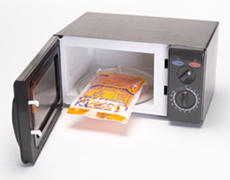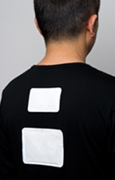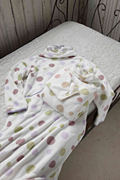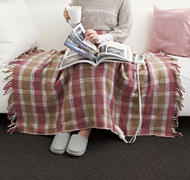Web Japan > Trends in Japan > Tech & Life > Winter Life in Japan
Winter Life in Japan
Ways to Endure the Winter Cold

Kotatsu, the traditional winter warm-up item, are now coordinated with stylish coverings to suit modern lifestyles. (Cooperation: MUJI Yurakucho Store, Ryohin Keikaku Co., Ltd.)
Enlarge photoExtending from north to south across the sub-arctic and subtropical zones, the Japanese archipelago experiences a highly diverse climate, but most of the country, except for the southern islands, experiences the coldness of winter. Temperatures frequently fall below minus 15 degrees Celsius in Hokkaido, the northernmost prefecture. The Hokuriku region, facing the Japan Sea on the northwestern coast of Japan's main island of Honshu, is well known as an area of heavy snowfall. Even in the country's capital of Tokyo, the average temperature in January hovers below five degrees Celsius. So just how have the Japanese found ways to keep warm during this chilly winter season?
Kotatsu—An Innovation Loved by the Japanese from Olden Times to TodayIn Japan, the kotatsu is an essential heater during the winter. It is a low-lying table placed over a heat source and covered with blankets to trap the heat around the users' legs. Invented during the country's Muromachi era (14th to 16th century), the kotatsu was originally placed over a fire smoldering in a hearth on the floor to keep everyone warm. Later on, the heat source changed to charcoal, and finally, in the 1950s, the first electric kotatsu appeared featuring an electric heater fastened under the table. It quickly became popular throughout the country.
In more recent years, the kotatsu has been changing to suit people's lifestyles. Furniture-style models, which can be used as tables without the blanket in the warmer seasons, are already the norm, while a wide selection of kotatsu blankets and covers with simple designs are sold to appeal to the tastes of younger people.
Heaters, heated floors, and air-conditioners with heating functions are also used in Japan, but the kotatsu consumes less electricity. Therefore, many people are very thankful for these heated tables in the dead of winter, when people are very conscious of the rise in electricity consumption.
Staying Warm Anytime and Anyplace

Above: Often made of materials such as rubber and polyethylene, hot water bottles have seen a revival in popularity.
Below: A variety of cute coverings are available. (Cooperation: Cuse Berry)
Hot water bottles or bags are good friends at bedtime, as hot water filled in a container made of ceramic or other material keeps a bed warm. While they have been used from ancient times in China and Europe, hot water bottles have recently been given a fresh look in Japan from the perspectives of saving energy and ecological considerations. Many people, especially children and young women, like to use covers for their bottles that look like anime characters and are made to feel like stuffed toys, or that are embellished with cute designs. Other hot water bottle products include a charging type with a special liquid filler inside that can be used repeatedly simply by charging it for 15 to 20 minutes. Another model is a bag filled with a gel that, when heated in a microwave oven for 40 or 50 seconds, can keep the bag warm right through the night. Reusing these hot water containers in this way is highly economical.
More and more kinds of electric blankets have also hit the market, not only for use as bedding, but also as shawls, lap blankets, rugs, mats for napping on, sleeping bags, and leg covers. Also popular are blankets with sleeves that can be worn like a gown. Any time, no matter where they might be, people use these blankets as a way to keep warm.
Left: Yutapon, a gel-type hot water bag that can be heated with a microwave oven to maintain comfortable warmth (Cooperation: Hakugen)
Right: Disposable heat pads that attach to clothes are convenient. (Cooperation: Hakugen)
Called "kairo" in Japanese, hand warmers that can fit in a pocket are also highly convenient when going out in the cold. Long ago the Japanese used heated stones as a source of warmth, but in the modern era they came to use products that generate heat by oxidizing vaporized benzene with a platinum catalyst. Then, released around 30 years ago, disposable heat pads that use heat from the oxidation of fine iron fillings were seen as a revolutionary product, and they spread all over Japan. Often displayed in front of drug stores and supermarkets, a wide array of disposable heat pads is now available, with some types that attach to clothes and smaller versions that are placed under the feet.
Getting through the Winter with Self-Warming Underwear
Left: A gown-like "wearable blanket," which saves energy and provides warmth throughout the night (Cooperation: Nishikawa Sangyo Co., Ltd.)
Right: Electric lap warmer (Cooperation: Koden Co., Ltd.)
Ways of fighting the cold and warming up have been all the rage this winter, with people wearing lightweight and snug, body-fitting underwear that features heat-insulation properties. First sold by a major casual clothing company in 2003, this heat-insulating underwear is made with special moisture-absorbing, heat-generating synthetic fibers that were developed by a large Japanese materials manufacturer that possesses highly advanced technologies. When perspiration emitted from the body is absorbed by the high-tech fibers, it is changed into heat energy, causing the material to warm up by itself. The clothing company teamed up with the materials manufacturer to make a series of underwear using this technology. As a result, we now have a great way to beat the winter cold. The underwear is not only thin and warm; it also has excellent insulation, moisture-retention, bacteria- and odor-resistant, and humidity control properties, as well as good elasticity. An instant hit in Japan, especially with the younger generation, the product is now being sold in Asia, Europe, and North America, with sales of over 80 million items annually.
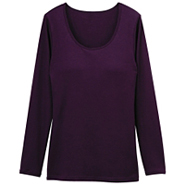
|

The warm and yet thin HEATTECH innerwear series for women. The series led the boom in the functional, heat-retaining underwear. (Cooperation: UNIQLO, Fast Retailing Co., Ltd.) |
Nowadays, a large number of big clothing manufacturers, underwear makers, and sporting goods companies are developing functional underwear and marketing such products. Especially during this past winter, with the nation's strong determination to save electricity as a background, many companies bolstered their marketing of these types of enhanced products in anticipation of a growth in sales, and many people in Japan, regardless of age or gender, started wearing heat-insulating underwear.
How to ensure comfort during the winter cold is a challenge that the Japanese have met in many ways throughout the ages, and today, everyone seems to be able to get through the chilly winter season feeling very warm and cozy.
(March 2012)
- Gentle Yet Effective (March 2012)

